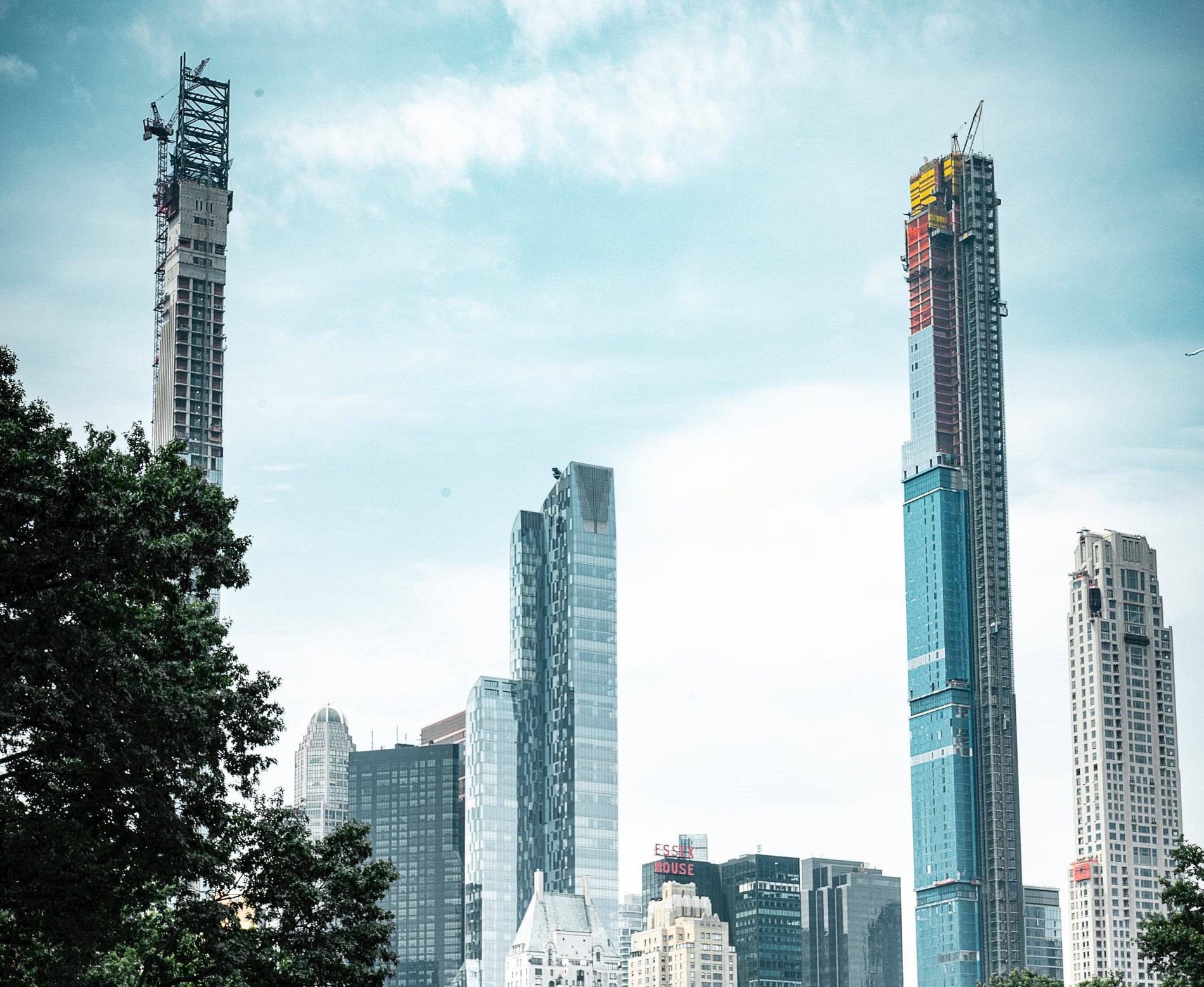A product of New York City’s property boom in the recent years, the area along the southern end of Central Park dubbed ‘Billionaires’ Row’ is beginning to have its luxury and idyllic veneer removed. Many of the super slender skyscrapers in this area were designed through the focus of a residential lens and yet like many elite real estate developments, a lot of the units remain empty. It’s worth noting that these units have been purchased, but due to a plethora of reasons, their uninhabited status for the majority of the year has created a billion dollar ghost town in the heart of Manhattan . Centred around 57th Street, there has always been controversy linked to these ultra-expensive developments but it has been more recent events surrounding the supertall skyscraper, 432 Park Avenue, that have inspired today’s post.
Understanding Billionaires’ Row and New York’s zoning laws
In recent decades, the urban architectural landscape has seen a resurgence in the arms battle for who can build the tallest buildings. Realistically, do we need the ridiculously tall and thin skyscrapers being constructed in places like New York, Dubai and East Asia? Absolutely not. While they may look the part, these structures are no more than glass vanity projects for countries and cities to boost their image. The epitome of this phenomenon has got to be the addition of entirely pointless masts and spires on skyscrapers incorporated solely to make them taller than their competitors. While in Dubai and other more sparsely developed locations, these structures can be designed with wide bases and sprawling foundations, the already confined space of Midtown Manhattan has led to the genesis of a new obsession for developers: super slender skyscrapers. It is along the southern border of Central Park, in the area dubbed Billionaires’ Row, that the hub of these New York pencil-thin skyscrapers are located.
A pivotal concept to understand when analysing these super thin structures is something called ‘air rights’. Dating back to 1797, the idea of air rights is legally encoded in the Latin phrase: “Cuius est solum, eius usque ad caelum et ad inferos”, translating to mean “For whoever owns the soil, it is theirs up to heaven and down to hell”. In essence, a property owns all the invisible air space that is directly above their lot diameter – an asset that in a heavily populated ground level area is extremely valuable in the real estate market. Also referred to by the term ‘Transferable Development Rights’, air rights can be sold to neighbouring properties if they’re unused. The ‘Floor Area Ratio’ which underpins New York’s zoning legislation dictates buildings can’t exceed the floor area designated to that single lot, however as the diagram below shows, while the overall floor area doesn’t change developers can stack up their floor space to gain taller structures.

With air rights being tangible assets people can buy and sell, the end result is developers buying up adjacent air rights and proceeding to stack them on top of their own existing floor area. It is important to note that since 1961, a property only has to share 10 feet (around 3m) of their lot line, which if you equate to Midtown urban building perimeters is a very short distance for both properties to share. As was the case with Billionaires’ row, the actual floor lot sizes are relatively tiny and if we take a look at 432 Park Avenue and 111W57th Street in particular, the height to width ratios are an incredible 15:1 and 24:1 respectively. Not all of the skyscrapers on Billionaires’ Row share ratios that extreme, but they do all share the common principle of buying up air rights like it’s a winner-takes-all game of Monopoly. Ultimately, the fact that something invisible like ‘air space’ can be given a quantifiable price and traded amongst people is a clear indictment of the spurious nature of the Capitalist market. Wait until we get onto the prices of these properties for even more astronomical ridiculousness!

The structural problems of a super slender skyscraper:
As you can imagine, with such high height to width ratios, the process of building these slender skyscrapers requires somewhat of an engineering masterclass. For this segment I am going to focus on the numbers and features behind 432 Park Avenue because being the thinnest of the lot it had the most complications. Underneath the property are 60 rock anchors that descend about 21m into the bedrock, while the structure itself has a 9.1m square reinforced concrete core with 0.76m thick walls located in its centre. A big problem with extremely thin designs like 432 Park Avenue is the wind, insofar as its dimensions make it very prone to swaying – not the most desirable quality to have for luxury apartments. In an attempt to mitigate this problem, after all the height of the building was never going to be reduced, it was suggested that every 14 floors would be a two-storey windbreak. These levels contained modular mechanical services as well as being open and unenclosed, allowing the wind to pass through the structure – an idea that in theory I must admit is quite clever. In addition to the windbreaks are a series of mass dampers located throughout the structure which aim to counteract the swaying and diminish the structure’s oscillations whenever heavy wind passed by.
Just over half a decade since its completion, the structural problems of 432 Park Avenue are beginning to surface, almost all of which can be attributed to the height of the tower to some degree. While the CIM Group, one of the building’s developers, claim the structure is “successfully designed and constructed”, there have been two leaks around the windbreak levels which led to flooding of elevator shafts and a number of floors. Furthermore, many residents have made noise complaints regarding the sound of rushing air and groans as the building sways, resembling something akin to a ghost ship. These malfunctions and defects have not only caused damage to the property, but residents are experiencing a sharp increase in their insurance rates too – hardly the sort of problems you want to be dealing with in what is advertised as an ultra-luxurious, crème de la creme mode of Midtown living.

The crazy realm of property prices on Billionaire’s Row
Billionaire’s Row is the epitome of New York’s ever increasing cost of living and ostentatious wealth, so much so that the Los Angeles Times ran an article stating 432 Park Avenue was “an architectural emblem of rising inequality”. They’re not wrong. The recent boom in developments and influx of foreign wealth is create a huge disparity between the ultra-elite and the average New Yorker. The problem for me lies in New York’s direction as a city wherein it is neglecting a lot of its citizens in favour of showing off fancy new projects and initiatives which benefit a minority and further exacerbate the class gap. As Katie Warren writes in her article, “As a New Yorker, I’d rather live closer to the ground in a diverse neighbourhood than 1000ft high in the clouds of Midtown surrounded by absent millionaires and billionaires.”
If we get into the actual pricing of real estate in these slender skyscrapers you can quickly see why local real estate company StreetEasy describe the area as an “enclave that’s become a symbol of the city’s increasingly stupendous riches”. The median sale on Central Park South is $9.8 million while a penthouse suite in 220 Central Park South went for $238 million back in 2019. If we go back to 432 Park Avenue, prices for apartments are around the $18.4 million mark and in total the sale of all units meant the building was expected to bring in $3.1 billion in profit. Bearing in mind the problems I mentioned earlier regarding 432 Park Avenue (it’s worth noting many of the other buildings have experienced similar problems too) it seems absolutely absurd to have units going for such astronomical prices. It can be concluded therefore, that not only does Billionaire’s Row have a plethora of its own problems in the structural realm, it wholly reinforces the problems facing the city in a more social and financial way.
For further reading see: How New York’s rising trend of ‘supertall’ towers looks from the 92nd floor, The Downside to Life in a Supertall Tower: Leaks, Creaks, Breaks and make sure to check out my socials: Instagram @Fourfacadesblog


Insightful article highlighting the crazy, absurd prices for these properties in the cloud in NYC.
A city with huge differences of wealth and housing showcasing the elite and privileged with their high profile spending for aesthetics against the inequalities for the ordinary resident looking to make this city their home.